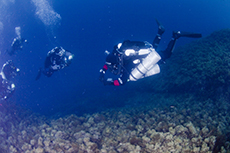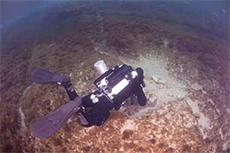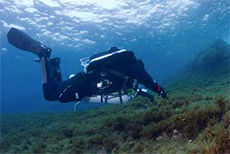




| Home | Features | Club Nights | Underwater Pics | Feedback | Non-Celebrity Diver | Events | 8 August 2025 |
| Blog | Archive | Medical FAQs | Competitions | Travel Offers | The Crew | Contact Us | MDC | LDC |

|

|
 
 |
   ISSUE 17 ARCHIVE - TECHNICAL DIVING AND REBREATHERSPaolo Vincenzo ToomerA while back I did a 100 metre training dive with an extremely accomplished diver. Due tosome unforeseen circumstances we had some pretty (!) serious complications on the dive which led to several very hairy minutes while we regained control of a potentially life threatening situation. Can you imagine being deep underwater and you have a major issue that leads to an unacceptable stress level that then forces your breathing rate to increase substantially? As this happens, you realise that the surface is 11 atmos- pheres away and around 80 minutes worth of decompression stops. On top of that you have three decompression gas switches to gasses that are only breathable at certain depths. It also dawns on you that the gas you are breathing will first of all run out way before you reach the surface and secondly, it is so low in oxygen that it will not sustain life even if you do make it. Get this wrong and you are in a whole world of hurt. Fortunately, your training kicks in, you bring it all under control and you safely ascend and treat yourself to a well earned beer and perhaps a few tears or prayers. Up until this point I was a firm believer in diving in the identical kit to my students. It made perfect sense to me, but I was now starting to question this philosophy. I am an avid (read - totally nuts, mental about, bonkers) closed circuit rebreather (CCR) diver, as most of you already know. This got me thinking. If I did all the shallow dives and skill circuits wearing open circuit (OC) gear, but when we went deeper and I had nothing to demon- strate anymore, I could wear my CCR. But would it effectively make me safer (for want of a better word)? On analysing the phases of the dive, this is my reasoning why I will NEVER do an open circuit dive in the 100 metre mark again. Especially as I own and love my rebreather. First of all, my rebreather is less cluttered than my open circuit rig. No hoses looped around my neck, no backup regulator hose bungeed around my neck either, just my tidy breathing loop and integral open circuit bail out valve. When diving sub 70 metres, the bottom (back) gas is actually hypoxic (low O2) and relies on ambient pressure to bring it up to a breathable oxygen partial pressure. This means the open circuit diver has to use a travel gas to get to a depth where the back gas becomes breathable. Every time a diver switches gas there is a potential risk. On CCR the oxygen level is constantly maintained by the onboard electronics and is held for the entire dive. This means that we don’t have to switch on the way down. Of course my CCR will allow a massive amount more dive time than open circuit. The gas in my CCR can last easily 6 hours plus and the carbon dioxide scrubber can last three hours at least. When I reflected on the dive where we had problems, as an instructor I was thinking in second bytes at most. This was due to the fact that second by second we were using up our vital life support gas. When the issue occurred we were about ten minutes into the dive, we had very little bottom time available to us due to our gas supply. Whereas on a rebreather, after ten minutes of bottom time I would still have had literally hours of gas available, and nearly three hours of scrubber time. I also looked at the bailout gas for the CCR versus the decompression gas carried by the OC diver. The OC diver will use most of their back gas and decompression gas whereas the CCR diver will use none of their OC bailout gas, as long as the rebreather is working fine. This means that the bailout gas that the CCR diver is NOT using can now be used by the OC diver in the event of an emergency. Tell me this is not a wonderful thing. Now imagine there are several rebreather divers diving together, all with the correct OC bailout and enough to get safely to the surface. They are diving as a unit and not as individuals. This means that if three CCR divers are diving together and one fails, that person has enough gas to get him/her to the surface three times. You have to love life, sometimes it throws these curveballs at you. Sometimes they hit you in the head, sometimes they miss, but as educated divers we can take these adverse events and turn them to our advantage. I can tell you now, I am a much happier and, in my humble opinion, a safer deep technical diver. And there you have it, Paul’s first fully serious technical article! I would like to thank my student for allowing me to share this potentially horrific scenario so that we can all benefit from it. All opinions are my own and are in no way the opinions of Tanked Up, any training agencies or my fellow technical instructors. Paul is Director of Technical Training for SSI (Scuba Schools International). He owns Diving Matrix Tec Lab with facilities in London, Manchester, Red Sea and Malta. If you have any queries, Paul can be contacted on paul@divingmatrix.co.uk or paul.toomer@divessi.com or at the Diving Matrix website |